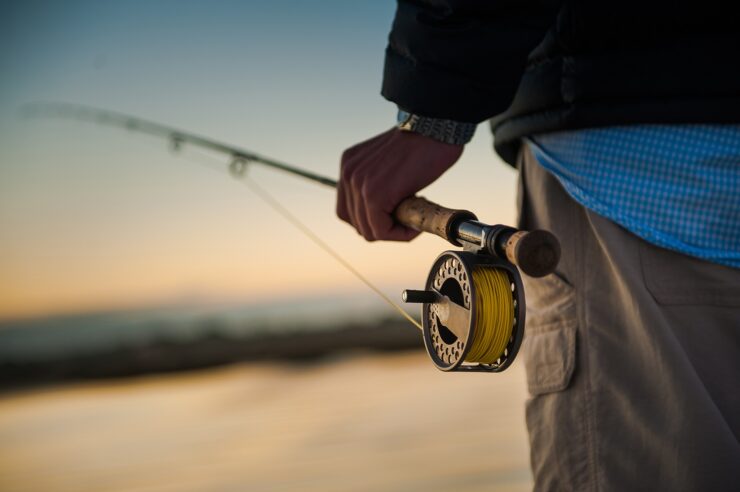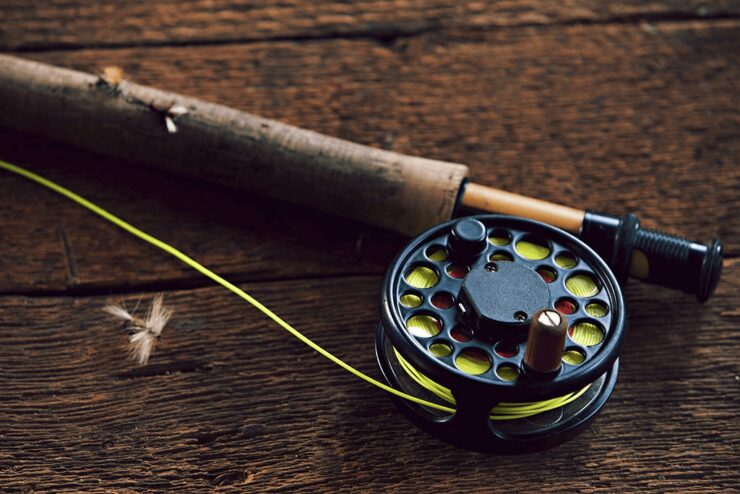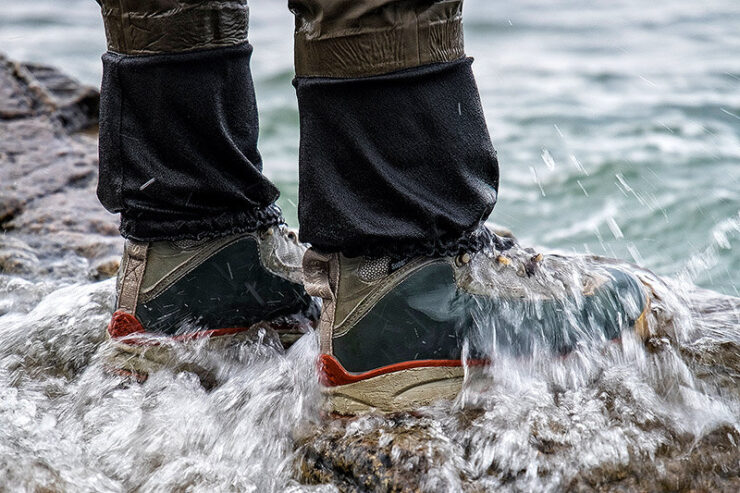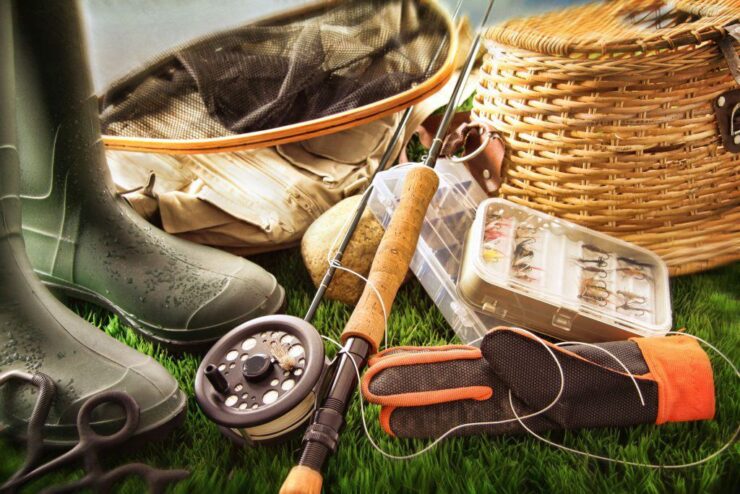Getting started in the ancient art of fly fishing is actually very similar to getting started in any other type of fishing in that you first need to acquire both the right equipment and basic knowledge of how to use it as well as determining what species of fish you will be fishing for and then finding a place to fish for them.
However, it should be noted that fly fishing is a gear-intensive sport, and thus, while a person can get started with nothing more than a fly rod, a fly reel, a fly line, a leader and, a few flies, there are several accessories that make fly fishing both easier and more pleasurable.
Consequently, many avid fly fishermen eventually find themselves collecting multiple fly rods, fly reels, and fly lines along with enough flies to supply a fly shop!
But, because the process of choosing an appropriate fly rod, fly reel, fly line, and fly line leader in addition to choosing an appropriate selection of flies is simply too complex to cover in a single article, this article will instead focus on the basics of fly fishing.
Fly Fishing Rods

So, because the fly rod is the heart of the fly casting system, it is appropriate that we start with a basic understanding of fly rods.
Thus, you should first be aware that fly rods are designed to enable a fly fishermen to pursue a very wide range of fish species in both fresh and saltwater environments and thus, they range from 5 feet to 15 feet in length and are designed to be cast either single-handed or double-handed depending on the distance over which an angler is casting.
Therefore, the amount of room an angler has to cast their fly is generally the determining factor in choosing an appropriate rod length while the size of the fly is the determining factor in choosing an appropriate fly line weight (more on this in a moment).
Furthermore, it is also important to be aware that each fly rod is designed to cast a specific fly weight and thus, all fly rods are designated by both their length and their line weight as well as their action. For instance, the 9 foot 5 weight fly is the single most popular freshwater fly rod due to its versatility while the 9 ft. 9 wt. is the single most popular saltwater fly rod for the same reason.
Choosing A Fly Line

Next, in order to cast a fly, an angler needs a fly line in addition to a fly rod. Thus, it is helpful to know that because artificial flies have very little weight and a high degree of wind resistance, they can only be cast with a weighted line.
Consequently, fly lines have a very different appearance than conventional fishing lines and they are each designated by weight which is determined by weighing the first 30 feet of the line.
Therefore, fly lines range in weight from 1 wt. to 14 wt. with 1 being the lightest and 14 being the heaviest. In addition, because of the way that fly lines are manufactured, they can be designed to either float on the water’s surface or sink beneath it at varying rates of speed which enables a fly fishermen target fish feeding both on and below the surface.
Therefore all fly lines are designated by the type of taper they have, their weight, and whether they are designed to float or sink.
However, again due to the manner in which fly lines are manufactured, even the tapered end of a fly line is simply too large and too stiff to enable an angler to attach an artificial fly to the end of the fly line.
Therefore, fly fishermen must attach a tapered length of monofilament called a fly line leader between the end of their fly line and their fly which then provides a significant amount of stealth to the fly casting system while also allowing the fly to land gently on the water’s surface.
Furthermore, although there are several different types of fly line leaders such as extruded, knotted, braided, and furled leaders, the knotless tapered leader (extruded) is the most readily available.
Fly Reel Basics
Then, of course, you will also need an appropriate fly reel to both stores your fly line and to aid you in fighting large fish species. Thus, it is helpful to be aware that fly reels are first dived into two categories consisting of those with a spring-and-pawl drag system and those with a disc or turbine drag system.
Then, they are further divided into those with standard, medium, or large arbors (the cylinder in the center of the spool). Consequently, most experienced fly fishermen prefer to reserve fly reels with spring-and-pawl drag systems and standard arbors for freshwater use with relatively short and/or lightweight fly rods while choosing fly reels with disc drag systems and medium to large arbors for fighting large, powerful, fish in both freshwater and saltwater.
Waders And Wading Boots

Last but not least, if you intend to fish in freshwater streams, then you will very likely need a pair of waders and a pair of specialized wading boots.
Thus, you should be aware that while some companies still offer neoprene waders, the very large majority of fly fishermen these days use waders made from a breathable but waterproof fabric.
In addition, you should also be aware that waders are available in two different types and three different heights. For instance, while some waders are manufactured with a rubber boot attached to each leg and thus are called “boot-foot” waders, the majority of them are manufactured with neoprene bootie instead and thus, they are called “stocking-foot” waders.
But, because stocking-foot waders lack a durable boot to protect them, they must be paired with a specialized pair of wading boots with either felt soles or sticky rubber soles. Thus, the very large majority of experienced fly fishermen have a distinct preference for stocking-foot waders over boot-foot waders because they not only fit far better, they provide the angler with a more stable platform when wading on a stream bed.
Now You Know The Basics
So, once a fly fisherman has acquired a fly rod, a fly reel, a fly line, and a fly line leader along with a pair of breathable waders and pair of specialized wading boots, the only other item that they need to hit the water and start enjoying this ancient form of fishing are an appropriate selection of flies and a few accessories such as dry fly floatant, strike indicators, a pair of nippers and a body of water with a viable fish population.
Adelaide Gentry, a seasoned kayaking enthusiast and expert, is the driving force behind KayakPaddling.net. With over a decade of experience navigating the world’s most challenging waterways, Adelaide combines her passion for adventure with a deep knowledge of kayaking to provide insightful and practical guidance for paddlers of all levels.
Related Posts:
- Heavy Duty Fishing: 11 Best Rods And Reels For Big Fish 2024
- 16 Best Kayak For Beginners 2024 - Kayaking Adventure Gear
- 10 Best Fishing Reel for Salmon 2024 - Reels for Big Gamers
- 10 Best Saltwater Fishing Boats - Ultimate Angling Adventure
- 12 Best Motorized Kayak 2024 - Start Your Aquatic Adventure!
- 14 Best Fishing Line for Baitcaster 2024 - For…












